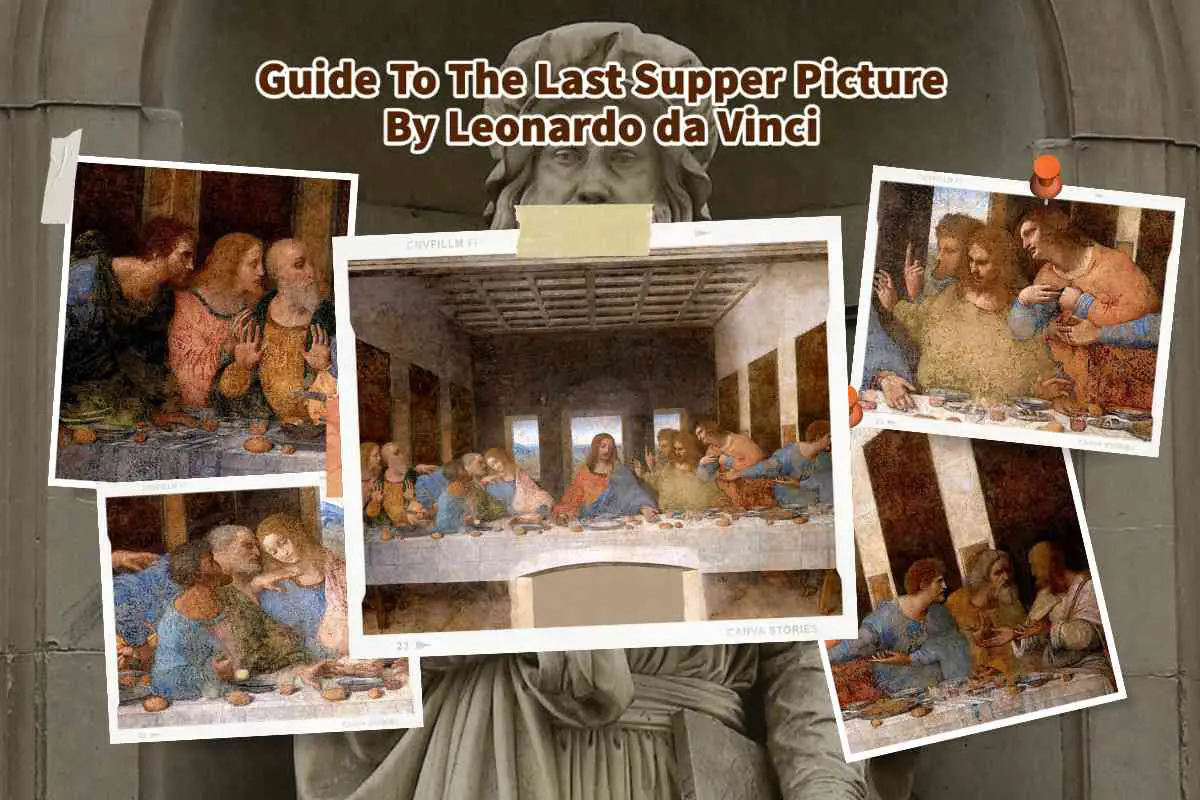The Last Supper by Leonardo da Vinci is one of history’s most celebrated and recognizable works of art. Leonardo’s masterpiece has captivated audiences for centuries with incredible detail, vivid colors, and intriguing symbolism.
Leonardo Da Vinci’s Last Supper painting is located in Milan, Italy. Even though the painting was so badly damaged, it has been restored and is still considered one of the greatest Renaissance masterpieces ever created. The Last Supper depicts the emotions of the apostles as Christ told them that one of them was going to betray them. The painting is filled with symbolism and emotion.
Table of Contents
- About The Last Supper Painting By Leonardo Da Vinci
- The Last Supper Captures The Emotions Of Christ And The 12 Apostles.
- The Last Supper Is In Milan, Not The Louvre In Paris
- Frequently Asked Questions
- Related Questions
About The Last Supper Painting By Leonardo Da Vinci

The Last Supper, painted by Leonardo da Vinci between 1495 and 1498, is one of the world’s most iconic works of art. The painting depicts the final meal shared by Jesus Christ and his apostles before His crucifixion.
Ludovico Sforza, the duke of Milan, for the refectory of Santa Maria Delle Grazie in Milan commissioned the painting. The massive size of the painting (14.5m x 8m) dictated the final composition and was integral to its meaning.
Sadly, Leonardo chose to seal the stone of the surface where he was painting and then used tempera paints. He did this so that, unlike fresco painting, he could paint over the tempera paints if needed.
That is why the last supper painting began to deteriorate almost from when it was finished. Just 70 years later, the biographer George Vasari described it as poorly done and deteriorating. It was a subject of a 20-year restoration campaign and remained one of the greatest renaissance paintings ever created.
In fact, over the centuries, many of the restorers used oil as they thought he had used oil, but they were mistaken because Leonardo Da Vinci used tempera paints for the painting.
The LastSupper painting shows the exact moment Christ told his apostles that one of them would betray him. The painting captures a moment of drama and emotion, with each apostle expressing different reactions to what has just been said.
The Last Supper Captures The Emotions Of Christ And The 12 Apostles.

One thing that makes the Last Supper such an iconic painting is that Leonardo da Vinci captured what he felt was the personality and the reaction of each of the 12 apostles when they understood that one of them was going to betray Christ. Because of this, the painting is full of symbolism, with the gestures and poses of each figure representing different aspects of Jesus’ teachings or their own lives.
The painting is one of the earliest examples of a ‘sacred conversation,’ with Jesus at its center surrounded by His apostles. When you see the painting, you see that Jesus is right in the center, with an almost casual or serene look.
The 13 figures in The Last Supper are all iconic in their own right, each representing different aspects of Jesus’ teachings. Here are some of the more notable symbols:
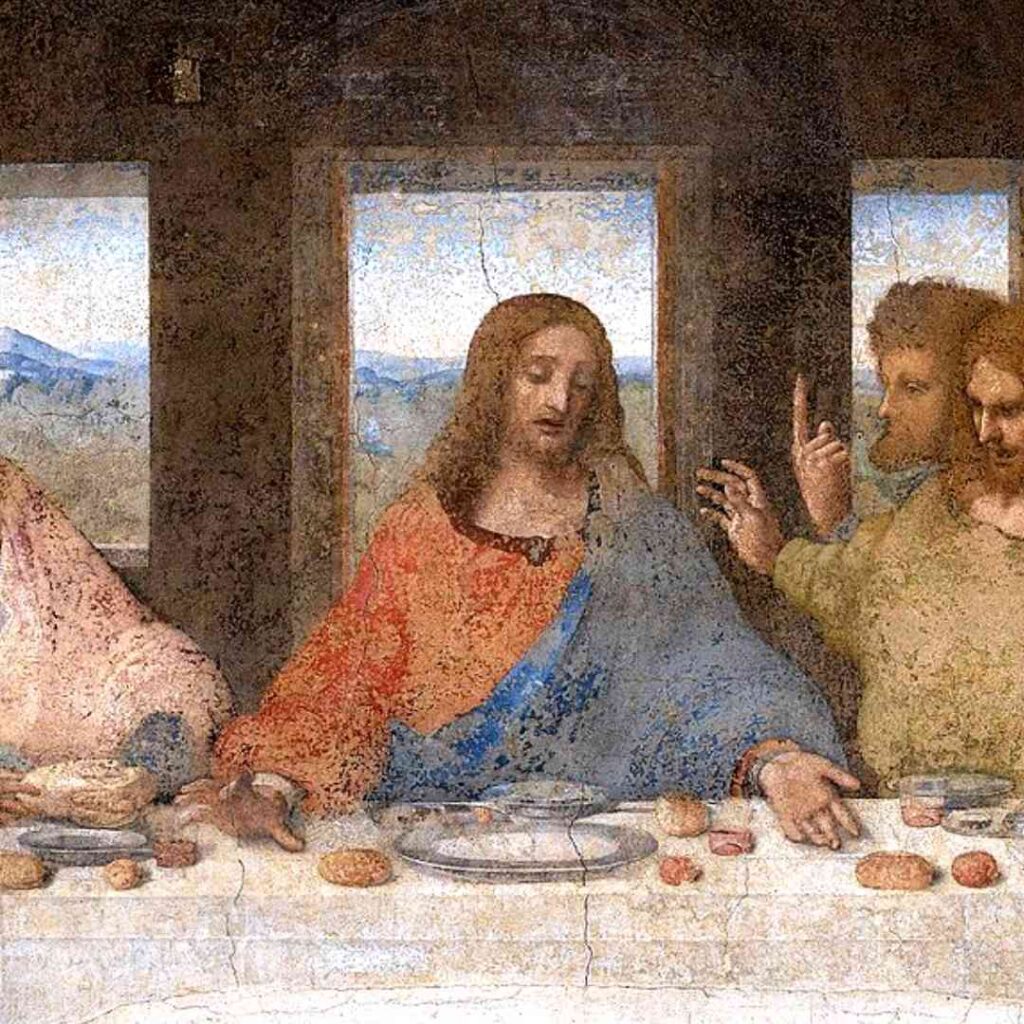
- Jesus is at the center; his palm is turned up, symbolizing the transition from physical to spiritual life.
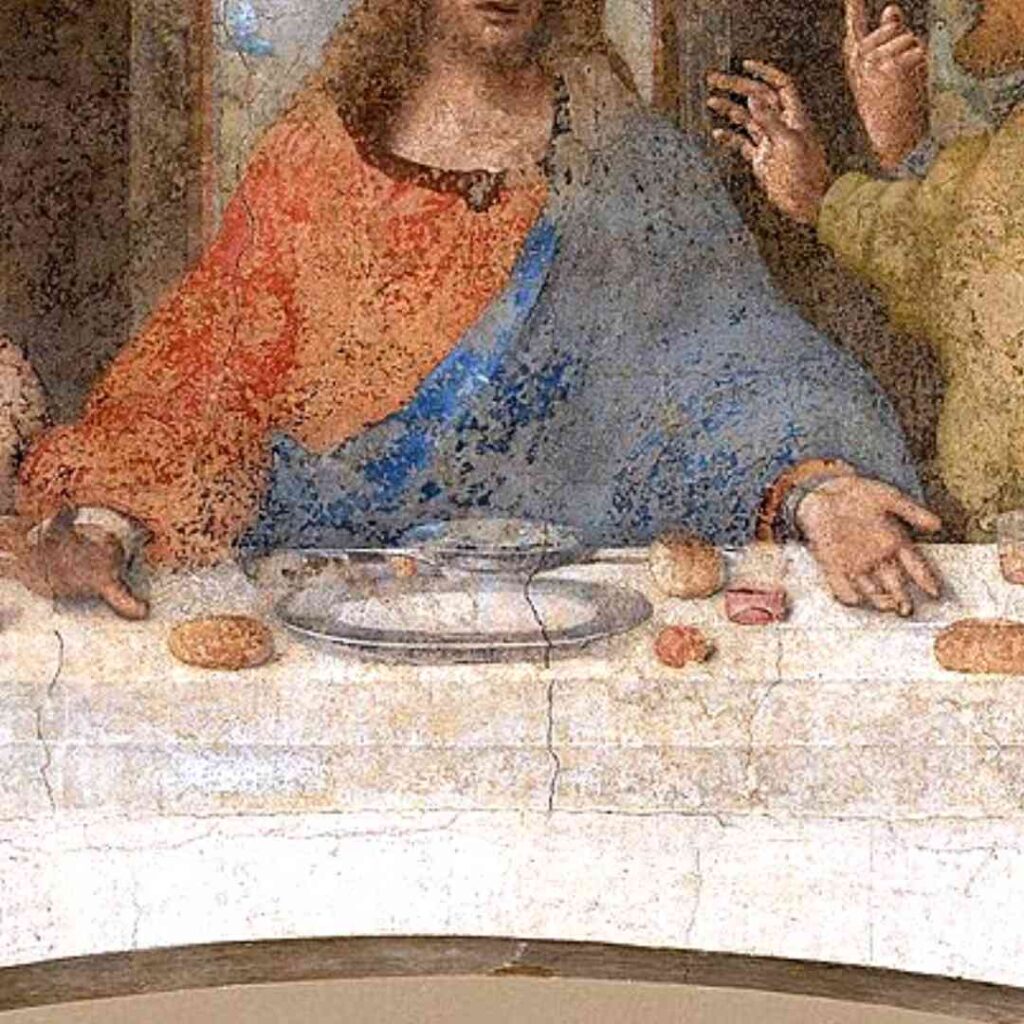
- On the table are bread and wine. Bread and wine symbolize the holy sacrament. Bread also symbolizes that Christ is the “Bread of Life.”
- Leonardo’s notebooks confirm who is in the Last Supper painting. They are essentially in 4 groups of 3 as follows:

- Group 1 Of The Apostles – Batholomew, James (minor), and Andrew are all surprised. They are all symbolically looking toward Christ.
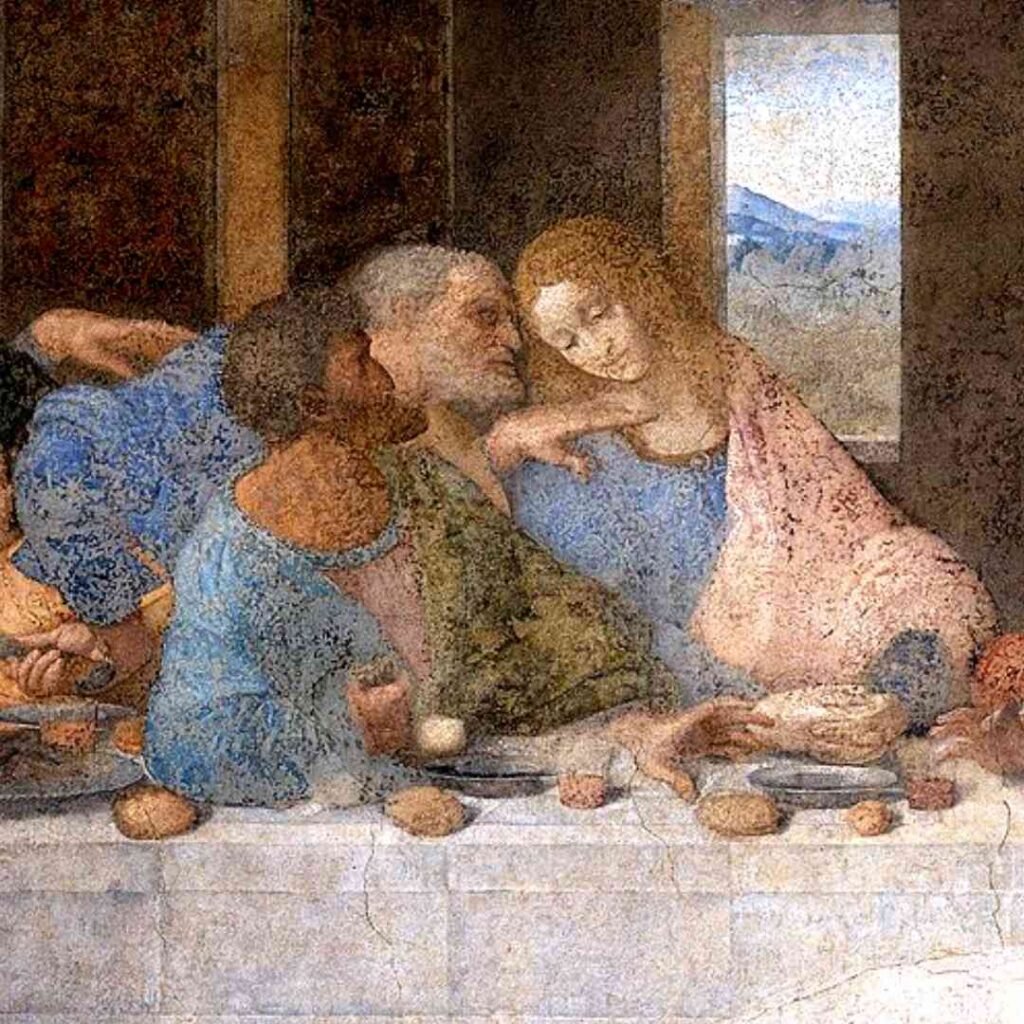
- Group 2 Of The Apostles – Judas Iscariot is taken aback and is holding tight to his purse (symbol of his betrayal of the 30 coins of silver), Peter is defiant and is holding fast to a knife, and John, the youngest apostle, is swooning back almost crying out in pain.
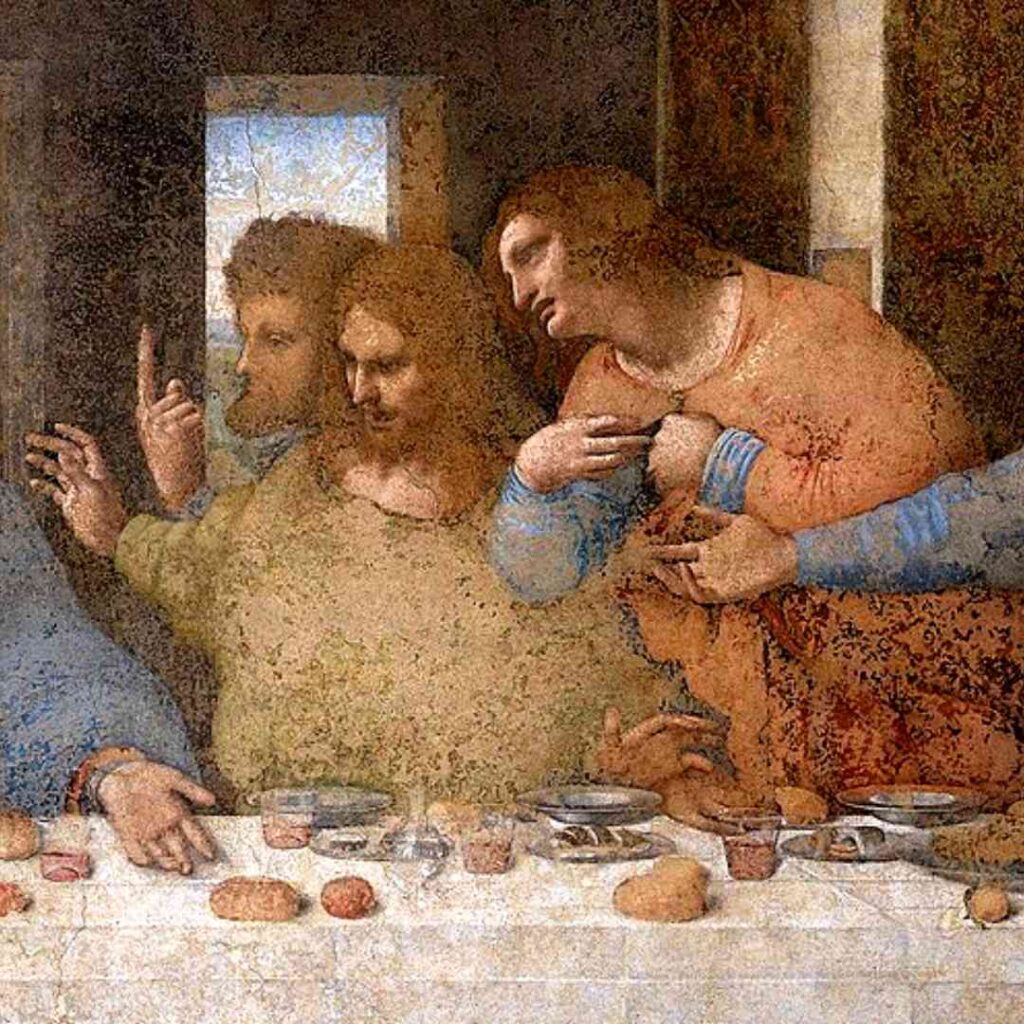
- Group 3 Of The Apostles – Thomas is upset and pointing his finger up, almost doubting what he hears; James (major) looks shocked and is reaching toward Christ while Philip is leaning in, almost like he does not think he heard correctly.
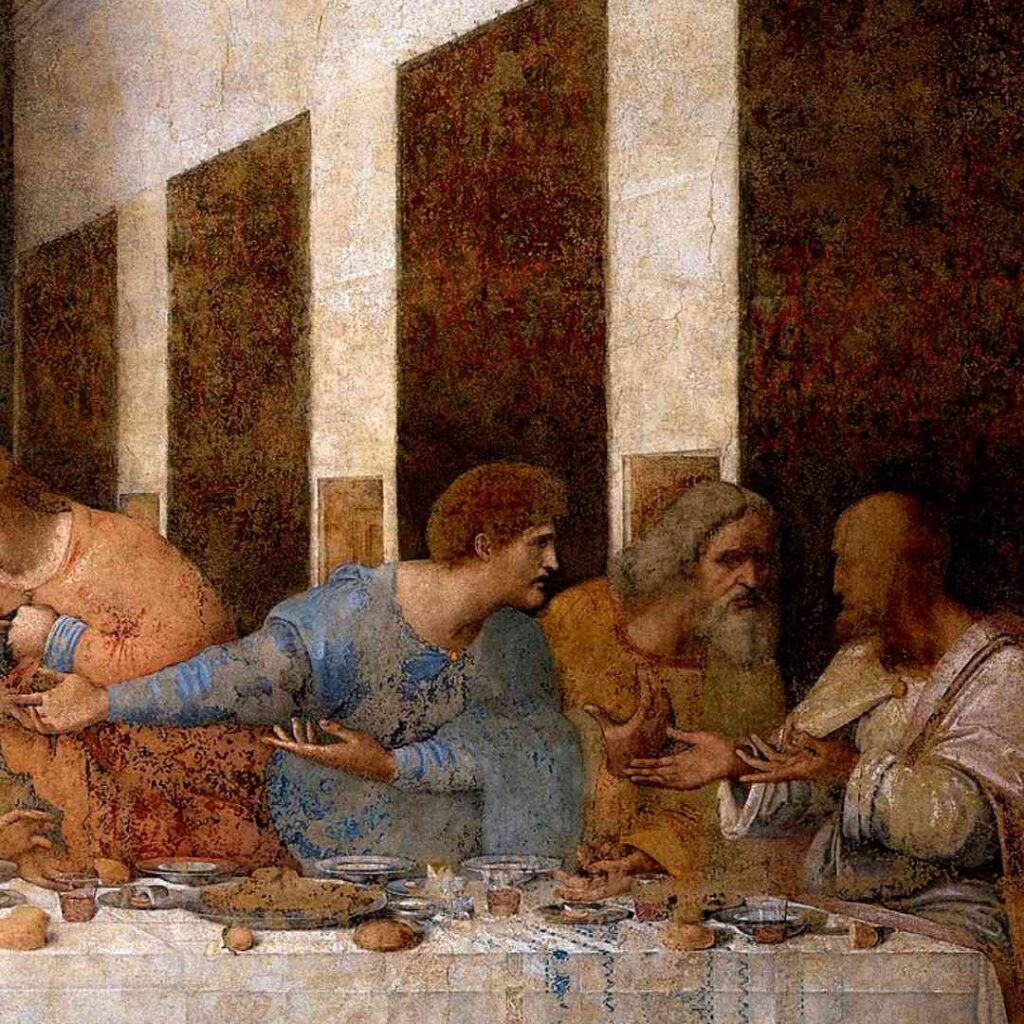
- Group 4 Of The Apostles – In the final group, Matthew and Thaddeus turn to Simon in the hope that he can explain and give them some answers.
The Last Supper has been an iconic work of art for centuries and continues to captivate viewers with its power and symbolism today. The painting has inspired many works of art over the centuries, including prints, sculptures, and even movie adaptations.
Even though the original painting has been damaged over time, and the original is no longer visible. However, The Last Supper continues to be an essential part of art history and still stands as one of Leonardo’s most significant works of genius.

Listen To Our Podcast About Unraveling the Secrets of the Last Supper by Leonardo da Vinci by clicking here.
The Last Supper Is In Milan, Not The Louvre In Paris
The original restored painting of The Last Supper by Leonardo da Vinci can now be seen in the refectory of Santa Maria Delle Grazie in Milan, Italy. The painting cannot be seen at the Louvre Museum in Paris, France.
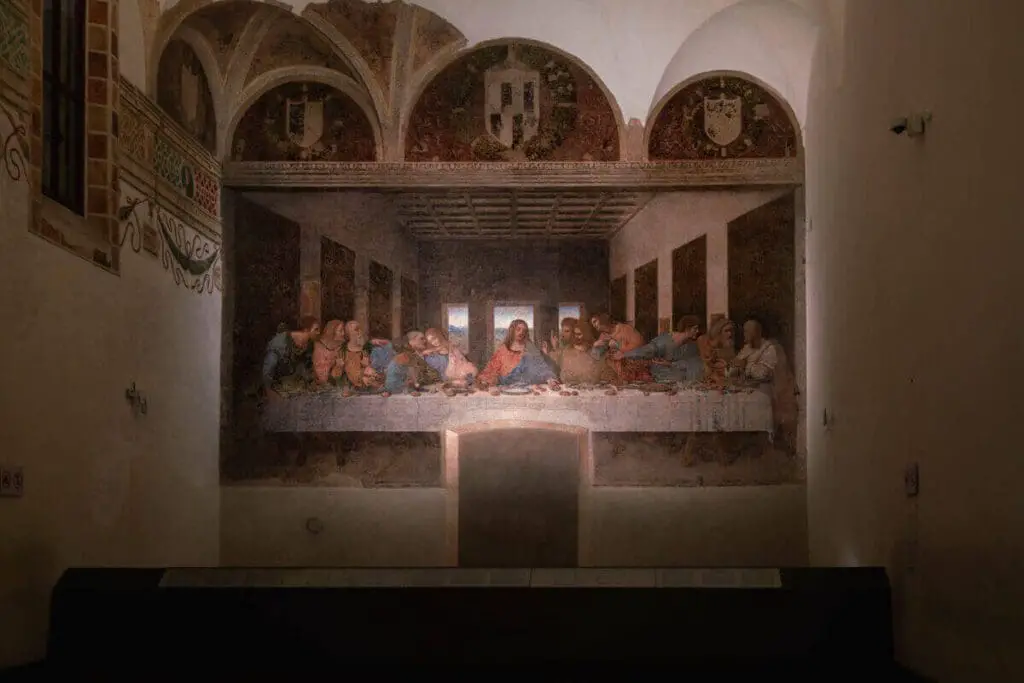
The Louvre shows Leonardo da Vinci’s famous Mona Lisa but does not show the last supper painting. You can only see the Last Supper painting at the Santa Maria Delle Grazie in Milan, Italy.
The Last Supper has been an iconic work of art for centuries and continues to captivate viewers with its power and symbolism. The painting’s popularity has endured for centuries, and its message resonates with viewers today.
Anita Louise Art is dedicated to art education, great artists, and inspiring others to find and create their art. We love art that uplifts and inspires. #ArtToMakeYouSmile! #ArtToMakeYouHappy!
If you are interested to see any of my art, you can find out more by clicking here. If you are interested in what inspires me and my paintings, you can discover more by clicking here.
We have a free newsletter and would love you to be part of our community; you can subscribe to the newsletter by clicking here. If you have any questions, I would be happy to talk to you anytime. You can reach me, Anita, by clicking here.
Subscribe to our Anita Louise Art YouTube Channel with great videos and information by clicking here.
Join us for our podcast “5 Minutes With Art.” Spend just 5 minutes a week with us to discover and learn about great art and artists. You can find out more about our podcast by clicking here.
Frequently Asked Questions
What is the significance of Leonardo da Vinci’s “The Last Supper” painting?
Leonardo da Vinci’s “The Last Supper” is considered one of the greatest masterpieces of the Renaissance era. It holds immense significance as it depicts the emotional moment when Jesus informs his apostles about the betrayal.
Where is “The Last Supper” painting located?
The iconic painting is located in Milan, Italy, specifically in the Convent of Santa Maria delle Grazie. It has been preserved despite considerable damage and restoration efforts.
What is the central theme of “The Last Supper” by Leonardo da Vinci?
The central theme revolves around the dramatic moment of Jesus revealing that one of his disciples would betray him. Leonardo captured the diverse emotions and reactions of the apostles during this revelation.
How did Leonardo da Vinci achieve such incredible detail in “The Last Supper”?
Leonardo’s meticulous attention to detail is a result of his innovative painting techniques, including the use of sfumato (smoky effect) and his keen observation of human expression and anatomy.
What symbolism is present in “The Last Supper” painting?
The painting is rich in symbolism, such as the use of gestures, facial expressions, and positioning of figures to convey various emotions and themes related to the events of the Last Supper.
Why is “The Last Supper” considered a challenging restoration project?
Over the centuries, the painting suffered from environmental factors and various restoration attempts. The delicate nature of the mural and its history presented challenges in preserving its original state.
How did Leonardo capture the emotions of the apostles in “The Last Supper”?
Leonardo employed his keen understanding of human emotions and anatomy to portray the varied reactions of the apostles, creating a dynamic and emotionally charged composition.
What makes “The Last Supper” different from other depictions of the Last Supper?
Leonardo’s rendition stands out for its innovative composition, unique portrayal of emotions, and the artist’s departure from traditional depictions, creating a more human and relatable narrative.
Is there a hidden meaning or code in “The Last Supper” painting?
Some theories suggest hidden meanings or codes within the painting, such as the placement of hands and objects. However, the true intentions behind these aspects remain a subject of scholarly debate.
How has “The Last Supper” influenced art and popular culture over the years?
The painting has left an indelible mark on art history and continues to influence artists and popular culture. Its portrayal of human emotion, composition, and storytelling has inspired countless interpretations, adaptations, and references in various forms of media.
Related Questions
Is There Any Painting Of The Young Leonardo da Vinci?
There is a painting by Giovanni Cariani (c. 1490-1547) at the National Gallery of Art, Washington DC, called Portrait of Man With a Dog (1520) that some people have said a painting of the younger Leonardo. Leonardo would have already been dead by the time this painting was completed. There is also a little-known artwork called Romanzo di Paolo e Daria by Gaspare Visconti that some feel is making fun of Leonardo da Vinci and his red hair.
By clicking here, you can learn more by reading Is There Any Painting Of The Young Leonardo da Vinci?.
What Inspired Leonardo da Vinci To Paint The Last Supper?
Duke Ludovico Sforza commissioned Leonardo to paint the Last Supper mural. What makes the Last Supper mural so unique is that he painted it at the exact time when Christ told the Apostles during The Last Supper meal that one of them would betray him. Leonardo showed the apostles’ reactions, including Judas, who betrayed Christ.
By clicking here, you can learn more by reading What Inspired Leonardo da Vinci To Paint The Last Supper?
Mona Lisa Painting And The Paris Louvre Museum
The Mona Lisa is one of the key paintings of the Louvre Museum. It is one of the most visited paintings in the world. The Mona Lisa is a painting studied, sung about, written about, and spoken about. There is still a mystery surrounding exactly who the Mona Lisa is and why Leonardo da Vinci painted it. This mystery adds to the allure of the painting.
By clicking here, you can learn more by reading Mona Lisa Painting And The Paris Louvre Museum.

